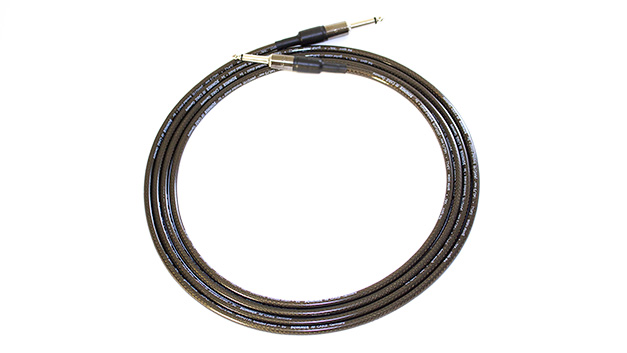GUITAR CABLE LENGTH AND SIGNAL LOSS
From: Shootout Guitar Cables UK • Best Guitar Cables Explained
See also: The Shootout Guitar Cables Range
BUY 'Black Powder' St-St 3m Guitar Cables on eBay - CLICK HERE! BUY 'Black Powder' St-Ra 3m Guitar Cables on eBay - CLICK HERE! |

|
Where passive guitar pickups are concerned the length of an unbuffered copper or silver signal core guitar cable as it pertains to increasing capacitance is the most significant aspect of the cable design that affects tone, other than extraneous interferance noise which just wrecks the signal rather than actually being part of it.

The formula for total guitar cable capacitance is very simple:
(Cable Length x Capacitance in Farads per Length Unit) + Jack Capacitance = Total Cable Capacitance in Farads.
Total unbuffered guitar cable capacitance forms part of a circuit with the high impedance inducting magentic pickup coils, the tone and volume controls, and the input impedance of the pedal or amplifier that it is connected to.
This circuit creates a low pass filter with around 12db/octave roll off with a significant resonant frequency boost before the high end frequency roll off loss.
The higher the total guitar cable capacitance, the lower the frequency at which the high frequency roll off loss begins.
For the least effect on the guitars tone an ultra low total cable capacitance allows the most high end frequency signal information through.
When the total cable capacitance is increased, the signal resonant frequency moves into lower frequencies, very audible even through inefficient guitar speaker cones, and this will have a radical affect on tone. The increasing lack of upper frequency signal information and harmonics will also affect how the guitar signal interacts with fuzz, treble boost, overdrive and distortion pedals.
The capacitance has a top down effect on the frequencies, so it does not affect 'bottom end' frequencies until total cable capacitance gets extremely high, by which time there would be no high and mid frequency information left anyway.
There is no such thing as 'sweet spot' capacitance per metre for a guitar cable, as it is the capacitance per metre (or foot) specification multiplied by the unbuffered length of the cable including jack capacitance that determines the resonant peak frequency and signal roll off frequency in combination with the passive pickup/s and volume/tone controls in use.
BUY 'Black Powder' St-St 3m Guitar Cables on eBay - CLICK HERE! BUY 'Black Powder' St-Ra 3m Guitar Cables on eBay - CLICK HERE! |

|
Also in this guide:
Guitar Cable Capacitance and Resonant Frequency
Guitar Cable Capacitance Chart
Guitar Cable Myths and The Cable Fairy
Guitar Cable Shielding and AC Hum
Braided vs Spiral vs Foil Guitar Cable Shielding
Guitar Cable Microphonics and the Triboelectric Effect
True Bypass Pedals vs Buffered Pedals
Silver Plated Copper Cables and 'Red Plague' Galvanic Corrosion
Copper vs Silver Signal Conductor Guitar Cables
Gold Plated Guitar Cable Jacks and Galvanic Corrosion
Guitar Cables vs Guitar Pedal Board Patch Cables
Analogue Guitar Cables vs WIFI
Low Capacitance vs High Capacitance Guitar Cables
Oxygen Free Copper Guitar Cables
Cheap vs Midrange vs Expensive Guitar Cables
Glued Heat Shrink vs Unglued Heat Shrink Guitar Cables
